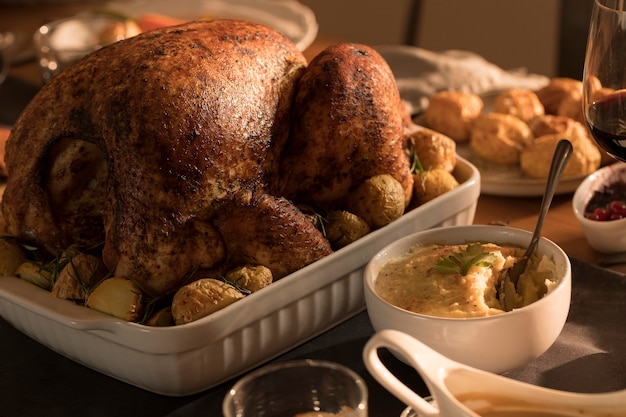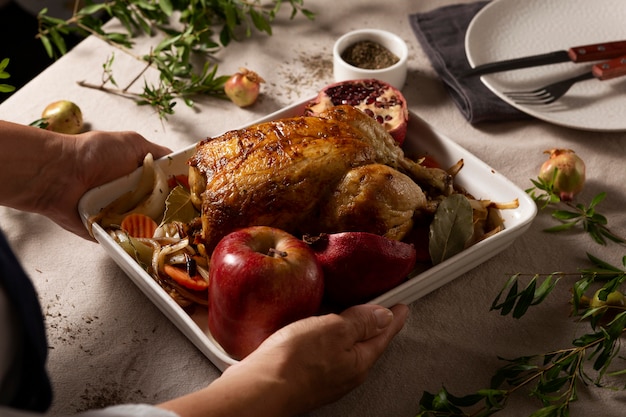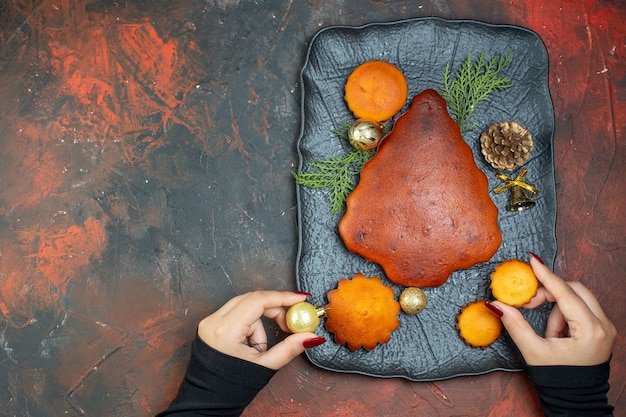You've got a 20-pound turkey, a centerpiece for your Christmas feast, and a whole lot of questions about how to cook it. How long do you cook it? What temperature should you use? Should you stuff it? These are the questions that plague every turkey-roasting novice and veteran alike. I've been there, and I'm here to tell you, it's not as daunting as it seems. With the right knowledge and a little bit of patience, you'll be serving a beautifully golden, juicy, and delicious turkey that'll have everyone singing your praises.
Over the years, I've learned a thing or two about cooking turkeys. There have been triumphs, like the year I nailed a perfectly roasted turkey that was so juicy, it practically melted in your mouth. But there have also been some less-than-stellar moments, like the time I accidentally overcooked a turkey and ended up with a dry, tough bird. It's these experiences that have taught me the most. I'm here to help you avoid those turkey tragedies, so you can enjoy a delicious Christmas dinner that everyone will remember for years to come.
(Part 1) The Foundation of a Successful Turkey Roast: Choosing the Right Recipe

The Power of a Good Recipe
Some people like to wing it in the kitchen (pun intended!), but when it comes to cooking a 20-pound turkey, a good recipe is your guide. It's not just a set of instructions, it's a roadmap that helps you navigate the journey from raw bird to a perfect roast. Think of it like a blueprint for success, ensuring you're using the correct ingredients, cooking times, and temperatures to achieve the best possible outcome.
Finding Your turkey recipe Soulmate
There are recipes out there for every type of turkey lover, from the traditional roast turkey with classic sage and onion stuffing to more adventurous recipes with exotic herbs, spices, and unique stuffing variations. Personally, I'm a sucker for a good old-fashioned roast turkey with sage and onion stuffing. It reminds me of Christmases past, filled with family, laughter, and the comforting aroma of roasting turkey. But if you're feeling adventurous, there's no shame in exploring new flavours and techniques.
However, before you jump into a recipe, I suggest taking a peek at a few different options. This helps you compare cooking times, temperatures, and ingredients, giving you a broader understanding of what works best. Don't forget to check the reviews! They provide valuable insight from fellow cooks, giving you a glimpse into how the recipe performed and whether it lived up to its promises.
(Part 2) The Weight of the Matter: Understanding turkey weight and Cooking Time

Why Weight Matters
You've got a 20-pound turkey. That's a big bird! It's important to remember that a larger turkey needs more time to cook through. Think of it like a giant marshmallow—you need to apply heat slowly and patiently so the warmth can reach the center, ensuring a perfectly cooked bird.
The Rough Guide to Turkey Cooking Times
Here's a general guide for roasting an unstuffed turkey, based on its weight:
| Turkey Weight (lbs) | Cooking Time (hrs) |
|---|---|
| 10-12 | 3-4 |
| 12-14 | 4-5 |
| 14-16 | 5-6 |
| 16-18 | 6-7 |
| 18-20 | 7-8 |
This is just a starting point. Remember to consider your chosen recipe, as it might provide a more specific cooking time based on its unique ingredients and instructions. But, this table gives you a general idea of how long to cook your turkey based on its size.
The Stuffing Factor: Adding Cooking Time for Stuffed Birds
Now, let's talk about the stuff inside the turkey - stuffing! Stuffing adds another layer of complexity to the cooking process. Since the stuffing needs to reach a safe internal temperature, you'll need to add about 30 minutes to your overall cooking time if you're stuffing your turkey. However, this brings us to a topic of debate: the safety of stuffing.
The Stuffing Debate: Inside or Outside the Bird?
Stuffing is a bit of a controversial topic when it comes to food safety. Some experts recommend cooking stuffing separately for better safety. This ensures the stuffing reaches the recommended internal temperature of 165°F (74°C), minimizing the risk of foodborne illness.
Personally, I enjoy stuffing my turkey, but I'm extra vigilant about ensuring it's cooked thoroughly. I always use a meat thermometer to check the internal temperature of the stuffing, making sure it reaches the safe mark. I also make sure the stuffing is moist and not too dense, which helps it cook evenly.
Ultimately, the decision to stuff your turkey or cook it separately comes down to your personal preference and comfort level. If you choose to stuff your turkey, be sure to follow food safety guidelines carefully and ensure the stuffing is cooked thoroughly.
(Part 3) The Oven's Role: Temperature and Cooking Time

The Oven as Your Turkey's Stage
Your oven is the stage for this grand turkey performance. The temperature you choose sets the pace for how quickly your turkey cooks. It's a balancing act - too high and the turkey will burn on the outside before the inside is cooked through, too low and it'll take forever. For a large bird like a 20-pound turkey, a low and slow approach is the best way to ensure a juicy and flavorful result.
The Standard Oven Temperature: 325°F (165°C)
The standard oven temperature for roasting a turkey is 325°F (165°C). This is a good starting point, especially for a larger turkey, as it allows the bird to cook evenly without drying out. But, always refer to your chosen recipe, as it might recommend a slightly different temperature depending on the ingredients and cooking method.
Adjusting the Temperature for Stuffed Turkeys
If you're stuffing your turkey, you might need to adjust the oven temperature. Lowering it to 300°F (150°C) allows more time for the stuffing to cook through. This might also mean slightly extending the cooking time to ensure both the turkey and stuffing are perfectly cooked. Remember, a properly cooked stuffing is crucial for food safety.
(Part 4) The Importance of Resting: A Little Relaxation for Your Turkey
Why Resting is Key: Juicier and Easier to Carve
Your turkey is out of the oven, golden brown and beautiful, but the cooking journey isn't over just yet. It's time for a little "turkey spa day" - a rest. Resting the turkey for at least 30 minutes after cooking is essential for a few reasons.
The Resting Process: Redistributing Juices and Cooling Down
While the turkey rests, the juices, which are trapped during cooking, redistribute throughout the meat. This results in a much juicier and more flavorful bird. Think of it like a little party for the juices - resting time allows them to mingle and spread the love, ensuring every bite is packed with flavor. Additionally, resting helps the turkey cool down slightly, making it easier to carve.
Covering the Bird: Trapping Heat and Keeping it Cozy
To help the turkey rest properly, cover it with a piece of foil. This creates a cozy little environment that traps the heat and allows the juices to redistribute evenly. Don't worry, the foil won't steam the turkey; it will simply create a barrier that helps maintain the temperature and keep the bird moist.
(Part 5) Unveiling a Perfectly Cooked Turkey: Signs of Doneness
Time to Check: Visual Clues, Touch Test, and the Meat Thermometer
After the turkey has rested, it's time to see if it's truly ready for the big reveal. You can use your eyes, your fingers, and a trusty meat thermometer to determine if the turkey is perfectly cooked.
Visual Clues: Golden Brown Skin and Clear Juices
First, take a peek at the turkey's skin. It should be a beautiful golden brown colour, indicating the turkey has been cooked thoroughly. The juices running from the thickest part of the thigh should also be clear. If the juices are still pink, it means the bird needs a bit more time in the oven.
The Touch Test: A Firm and Steady Thigh
You can also check the turkey by giving it a gentle poke with your finger. The thigh should feel firm and not jiggly. If it still feels soft, give it a few more minutes in the oven.
The Meat Thermometer Test: The Ultimate Doneness Indicator
Now, for the ultimate test, grab your trusty meat thermometer. Insert it into the thickest part of the thigh, making sure it doesn't touch any bone. The thermometer should read 165°F (74°C) to ensure the turkey is cooked through.
Checking the Stuffing Temperature: Ensuring Food Safety
If you've stuffed the turkey, don't forget to check the internal temperature of the stuffing. It should also be 165°F (74°C). If the stuffing is undercooked, it's best to remove it from the bird and cook it separately in the oven to ensure it reaches a safe temperature.
(Part 6) Carving Your Turkey: A Step-by-Step Guide to Success
The Art of Carving: A Skill for Every Cook
You've got a perfectly cooked turkey, and it's time to carve it up. Don't be intimidated, carving a turkey is easier than you think! A sharp carving knife and a carving fork will be your best friends in this process.
Carving Steps: A Clear and Concise Guide
Here's a step-by-step guide to carving your turkey like a pro:
- Place the turkey on a cutting board.
- Use your sharp carving knife to separate the legs and thighs from the body. Cut along the joint where the leg meets the body.
- Remove the wings by cutting along the joint where they connect to the body.
- Carefully carve the breasts by cutting along the bone, creating slices of meat. You can use the knife to cut the breast meat into smaller pieces, if desired.
Serving the Turkey: A Feast for the Senses
Once you've carved the turkey, it's time to serve it up. Use a carving platter or serving plates. Don't forget to serve the turkey with your favourite sides, like gravy, stuffing, cranberry sauce, and roasted vegetables. This is the moment you've been working towards, a delicious and satisfying culmination of your hard work!
(Part 7) The Magic of Leftovers: Turning Leftover Turkey into New Dishes
Don't Let the Turkey Go to Waste: Delicious Leftover Ideas
Let's be honest, cooking a 20-pound turkey means you'll probably have some leftovers. But don't despair! Leftover turkey is a culinary treasure that can be transformed into a variety of delicious dishes.
Delicious Leftover Ideas: Turning Leftovers into New Feasts
Here are a few ideas to get your creative juices flowing:
- turkey sandwiches with cranberry sauce and mayonnaise.
- turkey salad with celery, grapes, and walnuts.
- Turkey noodle soup with carrots, celery, and potatoes.
- turkey pot pie with a flaky crust.
- Turkey and stuffing breakfast burritos with eggs, cheese, and salsa.
The possibilities are endless! Use your imagination and get creative with your leftover turkey. It's a great way to enjoy the flavour of your Christmas turkey for days to come.
(Part 8) FAQs: Common Questions and Answers About turkey roasting
1. What Happens if My Turkey is Overcooked?
If your turkey is overcooked, the meat will be dry and tough. This is something we all want to avoid! The best way to prevent overcooked turkey is to follow your recipe's instructions carefully and use a meat thermometer to check the internal temperature.
2. Can I Cook a Turkey on a Lower Temperature?
Yes, you can cook a turkey at a lower temperature, but it will take longer. For example, if you want to cook your turkey at 275°F (135°C), you will need to add about 1.5 to 2 hours to the cooking time. This is a good option for those who prefer a slower and more gentle cooking method.
3. Is it Safe to Stuff a Turkey?
As long as the stuffing reaches an internal temperature of 165°F (74°C), stuffing a turkey is safe. However, many experts recommend cooking the stuffing separately to ensure it's cooked thoroughly, as it can be challenging to monitor the stuffing's temperature inside the bird.
4. What if I Don't Have a Meat Thermometer?
While I highly recommend investing in a meat thermometer, it's not always an option. If you don't have one, you can check the turkey's doneness by looking for clear juices and a firm thigh. You can also check the turkey's internal temperature by poking it with a finger. The thigh should feel firm and not jiggly. However, it's important to remember that these methods are less precise than using a thermometer.
5. Can I Freeze Leftover Turkey?
Yes, you can freeze leftover turkey. It's best to freeze it in airtight containers or freezer bags. Leftover turkey can be frozen for up to 3 months. Thaw it in the refrigerator overnight before using it. frozen turkey can be used in a variety of dishes, like soups, stews, or even turkey sandwiches.
There you have it, a comprehensive guide to cooking a 20-pound stuffed turkey. Remember, it’s all about preparation, a good recipe, and a touch of patience. Grab your trusty turkey roasting pan, get your oven ready, and prepare for a delicious Christmas feast. Happy cooking!
Everyone is watching

Corn on the Cob: The Ultimate Guide to Perfectly Cooked Ears
Healthy MealsAh, corn on the cob. Just the name evokes images of sunny days, barbecues, and that sweet, juicy flavour that ...

Perfect Pork Roast Oven Cooking Time: A Guide to Delicious Results
Healthy MealsThere's something truly satisfying about a perfectly roasted pork. The aroma alone is enough to make your mout...

Scallops: The Ultimate Guide to Perfect Cooking
Healthy MealsAh, scallops. Those delicate, sweet, and utterly delicious morsels of the sea. They hold a special place in my...

Spaghetti Squash: The Ultimate Guide to Cooking and Serving
Healthy MealsRemember that time you saw spaghetti squash at the supermarket, looking all bumpy and strange, and thought, "W...

Ham Cooking Time: How Long to Bake, Smoke, or Boil a Delicious Ham
Healthy MealsAh, ham. It's a classic, isn't it? A real crowd-pleaser, especially around holidays. And when done right, it'...
